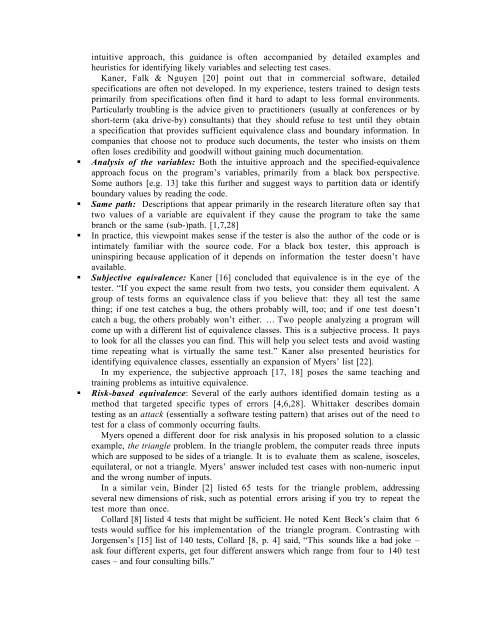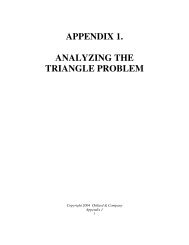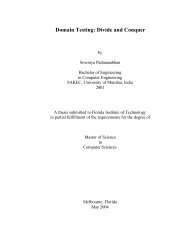Teaching Domain Testing: A Status Report - Testing Education
Teaching Domain Testing: A Status Report - Testing Education
Teaching Domain Testing: A Status Report - Testing Education
You also want an ePaper? Increase the reach of your titles
YUMPU automatically turns print PDFs into web optimized ePapers that Google loves.
intuitive approach, this guidance is often accompanied by detailed examples and<br />
heuristics for identifying likely variables and selecting test cases.<br />
Kaner, Falk & Nguyen [20] point out that in commercial software, detailed<br />
specifications are often not developed. In my experience, testers trained to design tests<br />
primarily from specifications often find it hard to adapt to less formal environments.<br />
Particularly troubling is the advice given to practitioners (usually at conferences or by<br />
short-term (aka drive-by) consultants) that they should refuse to test until they obtain<br />
a specification that provides sufficient equivalence class and boundary information. In<br />
companies that choose not to produce such documents, the tester who insists on them<br />
often loses credibility and goodwill without gaining much documentation.<br />
� Analysis of the variables: Both the intuitive approach and the specified-equivalence<br />
approach focus on the program’s variables, primarily from a black box perspective.<br />
Some authors [e.g. 13] take this further and suggest ways to partition data or identify<br />
boundary values by reading the code.<br />
� Same path: Descriptions that appear primarily in the research literature often say that<br />
two values of a variable are equivalent if they cause the program to take the same<br />
branch or the same (sub-)path. [1,7,28]<br />
� In practice, this viewpoint makes sense if the tester is also the author of the code or is<br />
intimately familiar with the source code. For a black box tester, this approach is<br />
uninspiring because application of it depends on information the tester doesn’t have<br />
available.<br />
� Subjective equivalence: Kaner [16] concluded that equivalence is in the eye of the<br />
tester. “If you expect the same result from two tests, you consider them equivalent. A<br />
group of tests forms an equivalence class if you believe that: they all test the same<br />
thing; if one test catches a bug, the others probably will, too; and if one test doesn’t<br />
catch a bug, the others probably won’t either. … Two people analyzing a program will<br />
come up with a different list of equivalence classes. This is a subjective process. It pays<br />
to look for all the classes you can find. This will help you select tests and avoid wasting<br />
time repeating what is virtually the same test.” Kaner also presented heuristics for<br />
identifying equivalence classes, essentially an expansion of Myers’ list [22].<br />
In my experience, the subjective approach [17, 18] poses the same teaching and<br />
training problems as intuitive equivalence.<br />
� Risk-based equivalence: Several of the early authors identified domain testing as a<br />
method that targeted specific types of errors [4,6,28]. Whittaker describes domain<br />
testing as an attack (essentially a software testing pattern) that arises out of the need to<br />
test for a class of commonly occurring faults.<br />
Myers opened a different door for risk analysis in his proposed solution to a classic<br />
example, the triangle problem. In the triangle problem, the computer reads three inputs<br />
which are supposed to be sides of a triangle. It is to evaluate them as scalene, isosceles,<br />
equilateral, or not a triangle. Myers’ answer included test cases with non-numeric input<br />
and the wrong number of inputs.<br />
In a similar vein, Binder [2] listed 65 tests for the triangle problem, addressing<br />
several new dimensions of risk, such as potential errors arising if you try to repeat the<br />
test more than once.<br />
Collard [8] listed 4 tests that might be sufficient. He noted Kent Beck’s claim that 6<br />
tests would suffice for his implementation of the triangle program. Contrasting with<br />
Jorgensen’s [15] list of 140 tests, Collard [8, p. 4] said, “This sounds like a bad joke –<br />
ask four different experts, get four different answers which range from four to 140 test<br />
cases – and four consulting bills.”








